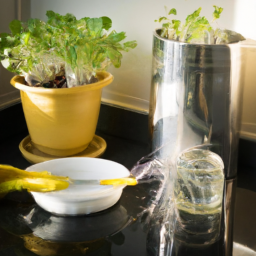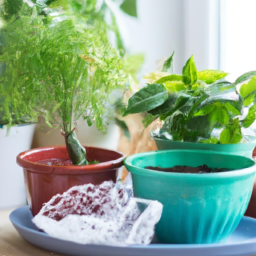
Have you ever wondered how indoor plants make their food? It’s a fascinating process that often goes unnoticed, but plays a crucial role in the growth and survival of these green companions. Indoor plants, just like their outdoor counterparts, have their own unique way of producing the energy they need to thrive. In this blog post, we will delve into the world of indoor plants and explore the intriguing question: how do indoor plants make their food? So, grab a cup of tea, sit back, and let’s embark on this botanical journey together!
The Process of Photosynthesis in Indoor Plants
Indoor plants have a remarkable ability to produce their own food through a process called photosynthesis. This intricate process involves the absorption of light energy, conversion of carbon dioxide and water into glucose, and the release of oxygen as a byproduct. In this article, we will explore the step-by-step guide on how indoor plants make their food through photosynthesis.
1. Absorption of Light Energy
Photosynthesis begins with the absorption of light energy by specialized pigments called chlorophyll, which are present in the chloroplasts of plant cells. These pigments are responsible for capturing light from the sun or artificial light sources, such as grow lights, which are commonly used for indoor gardening. The absorbed light energy is essential for the subsequent chemical reactions that occur during photosynthesis.
When light strikes the chlorophyll molecules, it excites the electrons within them, causing them to move to a higher energy state. This energy is then transferred to other molecules within the chloroplasts, initiating the photosynthetic process.
It is worth noting that different wavelengths of light have varying effects on photosynthesis. While plants primarily absorb red and blue light, they reflect green light, which is why plants appear green to our eyes. This is also why red and blue grow lights are commonly used for indoor plant cultivation, as they provide the necessary light spectrum for optimal photosynthesis.
2. Conversion of Carbon Dioxide and Water
Once the light energy is absorbed, indoor plants utilize it to convert carbon dioxide (CO2) and water (H2O) into glucose (C6H12O6) through a series of complex chemical reactions. This process occurs within the chloroplasts, specifically in a structure called the stroma.
Firstly, carbon dioxide molecules enter the leaves of the plant through tiny pores called stomata. These stomata are usually located on the underside of the leaves and allow for gas exchange between the plant and its surroundings. The carbon dioxide then diffuses into the cells of the leaf, where it encounters the chloroplasts.
Simultaneously, water is absorbed by the plant’s roots and transported through the stem to the leaves. Within the chloroplasts, water molecules are split through a process called photolysis, releasing electrons, hydrogen ions, and oxygen gas (O2) as byproducts. The released oxygen is then released into the atmosphere, contributing to the oxygen-rich environment we breathe.
The electrons and hydrogen ions produced during photolysis combine with the carbon dioxide molecules in a series of chemical reactions known as the Calvin cycle. These reactions utilize the energy from the absorbed light to convert the carbon dioxide molecules into glucose, which serves as the primary energy source for the plant.
3. Release of Oxygen and Glucose
As a result of photosynthesis, indoor plants release oxygen gas into the atmosphere. This oxygen is a vital component of the air we breathe and plays a crucial role in supporting life on Earth. Additionally, the glucose produced during photosynthesis is used by the plant for various metabolic processes, such as growth, reproduction, and the synthesis of other organic compounds.
Some of the glucose is stored as starch within the plant’s tissues, serving as a reserve of energy that can be utilized during periods of low light or limited water availability. The remaining glucose is transported throughout the plant to provide energy for cellular respiration, which is the process by which plants break down glucose to release energy for their metabolic activities.
In conclusion, indoor plants have a fascinating ability to create their own food through the process of photosynthesis. By absorbing light energy, converting carbon dioxide and water into glucose, and releasing oxygen as a byproduct, these plants sustain themselves and contribute to the overall balance of the ecosystem. Understanding this process allows us to appreciate the importance of providing adequate light, water, and nutrients to our indoor plants to support their growth and well-being.

Understanding the Role of Chlorophyll in Indoor Plant Nutrition
Indoor plants are not only beautiful additions to our homes and offices, but they also play a crucial role in purifying the air and providing a calming environment. Have you ever wondered how indoor plants make their own food? Well, the answer lies in the process of photosynthesis, and at the heart of this process is a pigment called chlorophyll.
What is Chlorophyll?
Chlorophyll is a green pigment that is responsible for the absorption of light energy from the sun. It is found in the chloroplasts of plant cells and is essential for the process of photosynthesis. There are several types of chlorophyll, with the most common ones being chlorophyll-a and chlorophyll-b.
Chlorophyll-a is the primary pigment that captures light energy, while chlorophyll-b helps in transferring this energy to chlorophyll-a. Together, these pigments play a vital role in the absorption and conversion of sunlight into chemical energy that plants can use to carry out their metabolic processes.
The Process of Photosynthesis
Photosynthesis is the process by which plants convert light energy into chemical energy in the form of glucose. This process occurs in the chloroplasts, which are specialized organelles found in plant cells. Let’s break down the steps of photosynthesis:
Step 1: Absorption of Light
When light hits the leaves or other green parts of the plant, chlorophyll molecules in the chloroplasts absorb the light energy. The energy is then transferred to the reaction center of the chlorophyll molecule, where it is used to power the next steps of photosynthesis.
Step 2: Splitting Water
In this step, water molecules are split into hydrogen ions (H+), electrons (e-), and oxygen (O2) through a process called photolysis. The electrons are used to replace the lost electrons in the chlorophyll molecule, while the oxygen is released into the atmosphere as a byproduct.
Step 3: Electron Transport Chain
The energized electrons from the chlorophyll molecule are now passed through a series of proteins in the thylakoid membrane of the chloroplast. This electron transport chain generates ATP (adenosine triphosphate), which is the primary energy currency in cells.
Step 4: Carbon Fixation
In this step, carbon dioxide (CO2) from the atmosphere enters the plant through tiny openings called stomata. The CO2 molecules are then converted into organic compounds, such as glucose, through a series of chemical reactions known as the Calvin cycle. This process is also known as carbon fixation.
Step 5: Production of Glucose
The glucose produced during carbon fixation is stored in various parts of the plant, including the leaves, stems, and roots. This glucose serves as a source of energy for the plant’s growth, development, and reproduction.
Factors Affecting Photosynthesis
While the process of photosynthesis is essential for indoor plants, several factors can affect its efficiency:
Light Intensity: Indoor plants require sufficient light to carry out photosynthesis effectively. Insufficient light can result in slow growth and weak plants. Providing adequate artificial light or placing the plants near a well-lit window can help overcome this limitation.
Temperature: Photosynthesis is temperature-dependent, with optimal temperatures varying for different plant species. Extreme temperatures, both hot and cold, can hinder the process and negatively impact plant growth.
Carbon Dioxide Levels: Higher levels of carbon dioxide can enhance the rate of photosynthesis. Increasing ventilation or using carbon dioxide supplements can help maintain optimal CO2 levels for indoor plants.
Water Availability: Water is essential for photosynthesis as it provides the necessary hydrogen ions for the process. Proper watering practices, avoiding both overwatering and underwatering, are crucial for indoor plants to thrive.
Conclusion
Understanding the role of chlorophyll in indoor plant nutrition is essential for providing the optimal conditions for their growth and well-being. The process of photosynthesis, driven by chlorophyll, allows plants to convert light energy into chemical energy in the form of glucose. By considering factors such as light intensity, temperature, carbon dioxide levels, and water availability, we can ensure that our indoor plants thrive and continue to provide us with their numerous benefits.

Exploring the Nutritional Requirements of Indoor Plants for Food Production
Indoor plants are not only aesthetically pleasing but also play a vital role in purifying the air we breathe. These green companions have the remarkable ability to create their own food through a process called photosynthesis. In this article, we will delve into the fascinating world of indoor plants and uncover the step-by-step guide on how they make their food.
The Miracle of Photosynthesis
Photosynthesis is the process by which plants convert sunlight, water, and carbon dioxide into glucose (a type of sugar) and oxygen. This remarkable feat takes place in specialized structures within plant cells called chloroplasts. The process can be divided into two main stages: the light-dependent reactions and the light-independent reactions.
During the light-dependent reactions, chlorophyll, the pigment responsible for capturing sunlight, absorbs light energy. This energy is then used to split water molecules into hydrogen and oxygen. The released oxygen is released into the atmosphere, while the hydrogen is utilized in the next stage.
In the light-independent reactions, also known as the Calvin cycle, the hydrogen molecules produced in the previous stage combine with carbon dioxide to form glucose. This process occurs within the chloroplasts and relies on enzymes and other compounds to facilitate the chemical reactions.
The Role of Nutrients in Indoor Plant Growth
While sunlight, water, and carbon dioxide are the primary ingredients for photosynthesis, indoor plants also require a range of nutrients to thrive and produce food. These nutrients are classified into two categories: macronutrients and micronutrients.
Macronutrients are needed in larger quantities and include nitrogen, phosphorus, and potassium. Nitrogen is vital for leaf and stem growth, phosphorus supports root development, and potassium aids in overall plant health and disease resistance.
Micronutrients, on the other hand, are required in smaller amounts but are equally important. These include iron, magnesium, zinc, and copper, among others. These micronutrients play crucial roles in various metabolic processes, enzyme activation, and overall plant health.
Providing the necessary nutrients for indoor plants can be achieved through various methods. One common approach is through the use of fertilizers. Fertilizers are formulated to contain specific ratios of macronutrients and micronutrients, ensuring that plants receive a balanced diet. It is important to follow the instructions provided on the fertilizer packaging to avoid over or underfeeding your plants.
Another method to provide nutrients is through organic matter. Compost or well-rotted manure can be added to the soil to enrich it with essential nutrients. This approach not only nourishes the plants but also improves soil structure and promotes beneficial microbial activity.
Optimizing Indoor Plant Nutrition
Each indoor plant species has its own unique nutritional requirements. Therefore, it is essential to understand the specific needs of your plants to ensure optimal growth and food production. Here are some key factors to consider:
1. Light: Adequate light is crucial for photosynthesis. Different plants have varying light requirements, so it is essential to place your indoor plants in locations where they can receive the appropriate amount of light. Some plants thrive in bright, indirect light, while others prefer low-light conditions.
2. Water: Watering your plants correctly is equally important. Overwatering can lead to root rot and nutrient deficiencies, while underwatering can cause wilting and stunted growth. It is recommended to water your plants when the top inch of soil feels dry, ensuring thorough but not excessive watering.
3. Temperature and Humidity: Indoor plants have specific temperature and humidity preferences. Most indoor plants thrive in temperatures between 60-75°F (15-24°C) and prefer moderate humidity levels. However, it is crucial to research the specific requirements of your plants, as some may have different temperature and humidity preferences.
4. Nutrient Monitoring: Regularly monitor the nutrient levels in your soil to ensure your plants are receiving the necessary nutrients. This can be done through soil testing kits or by observing any signs of nutrient deficiencies, such as yellowing leaves or stunted growth. Adjust the nutrient supply accordingly to maintain a healthy balance.
By understanding and fulfilling the nutritional requirements of your indoor plants, you can create an environment that promotes optimal growth and food production. Remember to observe your plants closely, as they may exhibit signs of nutrient deficiencies or excesses, allowing you to make timely adjustments to their diet.
Indoor plants are truly remarkable in their ability to harness sunlight and convert it into nourishment. By providing them with the right conditions and nutrients, we ensure their well-being while enjoying the benefits of their presence in our indoor spaces. So, let’s continue to nurture and appreciate these green companions that make our lives better.
In a Nutshell
Indoor plants are not just pretty decorations; they are living organisms that have a remarkable ability to make their own food. You might be wondering how they do it, especially when they are not exposed to sunlight like their outdoor counterparts. Well, the secret lies in a process called photosynthesis.
Photosynthesis is the magical process by which plants convert light energy into chemical energy, using carbon dioxide and water. Indoor plants have adapted to survive in low-light conditions by being more efficient in capturing and utilizing available light. They have specialized structures called chloroplasts, which contain a pigment called chlorophyll. Chlorophyll is what gives plants their green color and is essential for photosynthesis. Even though indoor plants receive less light, they are still able to produce enough food to survive and thrive. So, next time you admire your indoor plants, remember that they are not just beautiful, but also incredible self-sustaining organisms.
FAQ Roundup:
Q1: How do indoor plants make their food?
A1: Indoor plants make their food through a process called photosynthesis. They use sunlight, carbon dioxide, and water to produce glucose, which is their source of energy. The process takes place in the plant’s leaves, where chlorophyll, a pigment responsible for capturing sunlight, is present.
Q2: What is photosynthesis?
A2: Photosynthesis is the process by which plants convert sunlight into chemical energy in the form of glucose. It occurs in the chloroplasts of plant cells, specifically in the chlorophyll-containing cells of the leaves. During photosynthesis, plants absorb carbon dioxide from the air through tiny openings called stomata and use the energy from sunlight to combine it with water, producing glucose and releasing oxygen as a byproduct.
Q3: Why do indoor plants need sunlight for photosynthesis?
A3: Sunlight is crucial for photosynthesis because it provides the energy necessary to drive the chemical reactions involved in the process. The chlorophyll pigment in plant cells absorbs light energy, which is then converted into chemical energy used to synthesize glucose. Without sunlight, indoor plants would lack the energy source required to produce their food and sustain their growth.
Q4: Can indoor plants survive without natural sunlight?
A4: While most indoor plants thrive in natural sunlight, some can survive in low-light conditions or under artificial lighting. However, it’s important to note that without adequate light, the process of photosynthesis may be limited, resulting in slower growth and weaker plants. To compensate for the lack of natural light, you can use artificial grow lights specifically designed to provide the necessary spectrum of light for photosynthesis.
Q5: Do indoor plants need anything besides sunlight to make their food?
A5: Along with sunlight, indoor plants require carbon dioxide and water to carry out photosynthesis. Carbon dioxide is obtained from the air through the stomata on the plant’s leaves, while water is absorbed through the plant’s roots. These essential elements, combined with sunlight, allow indoor plants to produce glucose and oxygen, enabling them to grow and thrive.
Dr. Olivia Green is a botanist with over two decades of experience in indoor plant cultivation. She holds a Ph.D. in Plant Biology and has dedicated her career to researching plant behavior in controlled environments. Dr. Green is passionate about helping plant enthusiasts master the art of indoor gardening through her extensive knowledge and practical insights.


